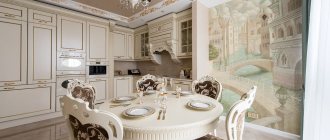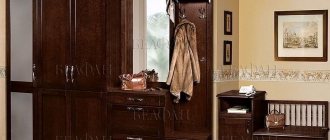The Soviet Union is a truly epoch-making state. During the history of its existence, this country had to go through several rounds of development, each of which was significantly different from one another. Moreover, the changes affected not only the state itself and the geopolitical ambitions and plans of its leadership, but also ordinary Soviet citizens. And all because the main person in that distant power, the General Secretary of the CPSU Central Committee, single-handedly made many decisions that very often had a direct bearing on the everyday life of ordinary people. In today’s article we will look at the conditions in which the citizens of the Soviet Union lived, or rather, let us remember the furnishings of their apartments and houses, first of all, the famous Soviet walls.
Examples of furniture from the Soviet era are still easy to find in typical Khrushchev and “Czech” buildings. Often these are products produced in the last years of the existence of the state, whose name is the USSR. This country has been gone for a quarter of a century, but it turned out to be an excellent manufacturer of furniture that still serves people today, like, in fact, many other things of that time.
Historical excursion
In the first years of the formation of the Union, the councils hardly thought about the conditions of the homes of workers and peasants. Those decades after the revolution were difficult for everyone, people had to use the furniture that they already had. At that time, even in the future, there was no such thing as “Soviet walls.”
All production capacities were aimed at establishing the state as such, and then at meeting the needs of the front. During these years, the main furniture producers in the country were wood processing plants and factories, sawmills, and small cooperatives where interior items were made by hand. The furnishings of rich houses of that time were distinguished by pretentiousness and pomp; it supported the canons of the pre-revolutionary years. Wardrobes, sideboards, chests of drawers and dressing tables were solid, massive, they were made of wood, often valuable species, and decorated with beautiful carvings and paintings. Few could afford this, and therefore these examples of furniture from the Soviet era are now the most valuable.
Ordinary people were content with rather rough cabinets and cabinets, cobbled together from what was at hand. There could be no talk of any aesthetics or luxury then.
Ten years after the end of the Great Patriotic War, the party decided that it was necessary to abandon excesses in construction. This provision also concerned the personal space of citizens, and therefore the interior furnishings of their homes.
Grandma's "antiques"
The population of the country at that distant time was placed in rather harsh living conditions. At that time, a massive migration of people from villages to cities began, including the capital of the Union. They had to live in communal apartments, dormitories or separate rooms, which were allocated by the townspeople for “limits” in order to generate additional income.
The cramped conditions forced many to get rid of the massive furnishings that cluttered their living spaces, and therefore high-quality and beautiful furniture, as well as sets that survived the revolution and were inherited by people, were mercilessly thrown away.
Those for whom the square meters allowed them to preserve antique furniture did not make a mistake, because it later became the envy of many, especially in conditions of the inaccessibility of modern analogues at that time. Soviet walls were a scarce commodity, a priority for many on the list of necessary purchases. People queued up for them, and families spent a long time saving money for new sets and sofas.
Living room in a classic style (+68 photos)
It is worth noting that classic style is a general concept that combines a number of different trends. As a rule, it is understood as: antique style, historical European styles of the 17th-19th centuries (classicism, empire style, baroque and rococo), national European traditional styles, as well as modern interiors, designed taking into account generally accepted traditional canons.
Today, the classic style is often carried out using modern advances in design. In addition, in one classic interior, you can find echoes of several traditional styles at once.
Be that as it may, a classic interior will always be distinguished by harmony, symmetry, solemnity, and the quality of finishing materials, textiles and accessories.
Therefore, to decorate a living room in a classic style, it is enough to follow the basic recommendations:
Symmetry.
The temperament of the style is expressed in the symmetrical arrangement of architectural forms and groups, as well as the severity of lines and clearly manifested geometry. Most often, in a classic interior, you can draw one or several conditional lines dividing the space into equal parts, and get sides that will mirror each other. Symmetry is of paramount importance for the ancient movement and classicism.
Grace and chic.
Centuries of existence of the movement have defined it as a style characteristic of the interior decoration of the homes of wealthy people. This is not surprising, because in the old days only wealthy people could afford to take care not only of having a roof over their heads, but also of the aesthetics of their own abode. It is noteworthy that the abundance of pompous decorative elements is more characteristic of Baroque and Rococo, while classicism can be distinguished by modesty and asceticism.
Naturalness of materials.
For finishing, furnishing and decoration, materials such as wood, stone, metal, and high-quality natural fabrics are suitable. Of course, today the market offers a large number of synthetic analogues of natural materials, however, it is the listed variants of the latter that refer to the authentic version of the trend, and will be able to recreate the sophistication inherent in the classic style.
Lighting.
It's no secret that until the beginning of the last century, electric light sources were extremely poorly distributed, as a result, one chandelier in the living room was not able to cope with its key task. In such a situation, alternative light sources on walls, fireplaces and tables came to the rescue. Thus, to complete the classic interior, you should take care of additional lighting in the room.
Not just apartments
At that time, there was no mass production of goods from the category of consumer goods, which included cabinets, walls, sideboards, dining sets, sofas and armchairs. However, the above-mentioned ruling changed the existing order of things. The government decided that it was necessary to provide the population with simple and affordable furniture.
This happened at a time when mass resettlement of people into separate apartments began. A lot of houses were built then, but the quality of the apartments in them left much to be desired. However, small, often adjacent rooms with low ceilings were still the ultimate dream for many.
Soviet furniture of that time was quite interesting. Factories have abandoned the use of natural wood for its manufacture, replacing this material with fiberboard and MDF. Designers then offered consumers products in the style of minimalism. If we describe the first Soviet walls, they can be characterized as small modules that consisted of two or three sections.
“Do you still have a sideboard? And we bought a wall!” — Furniture USSR
“What absurdities our ancestors reached! They agonized over every architectural project... And now in all cities they are building standard cinemas, standard multi-storey buildings... Identical staircases, painted in a standard pleasant color, standard apartments furnished with standard furniture, standard locks cut into the doors...” - this is how the famous Soviet comedy begins "Irony of Fate or Enjoy Your Bath!".
These words accurately convey the environment in which Soviet people lived. When people began to move from communal apartments to Khrushchevkas in order to meet communism in a separate apartment in 1980, the need arose to improve their private life.
Then a state, strictly centralized structure was created, regulating the relationship of a person with the objects around him. In 1962, by Decree of the Council of Ministers of the USSR No. 349 “On improving the quality of mechanical engineering products and cultural and household goods through the introduction of artistic design methods,” the All-Union Scientific Research Institute of Technical Aesthetics (VNIITE) was established with branches in the capitals of the union republics and in large industrial areas. This institution developed such branches of design science as rhythmics, modern color science, ergodesign, beauty economics, design programming, futuro design and many others.
The All-Union Furniture Design and Technology Institute (VPKTIM), created in 1962, was also involved in furniture design, where the masters of furniture design of the 1960s and early 1970s worked: Yu. V. Sluchevsky, K. K. Blomerius, E. S. Bocharova , E. Velbri et al. However, the standard Soviet furniture that filled the standard housing was simple, without unnecessary decor, economically and structurally rational. Elements and parts are unified; varnished fiberboard, chipboard, and plastic are used instead of wood. Excessive decoration and stylization slowed down mass production. Designers were in search of constructivism in the 20s and 30s.
One of the main pieces of furniture in the now defunct Soviet Union was the sideboard.
A sideboard is a low buffet consisting of two parts. The lower part is a cabinet, and the upper part is an extension, it looks like a smaller cabinet. Most often, the superstructure of the sideboard is glazed. It can be collapsible or non-collapsible. The height of the sideboard is usually small. There are often models with a wooden bottom, some of which have space for a small minibar.
Initially, the sideboard was intended to store dishes. Tea and coffee sets, sets of glasses and glasses, crystal sets, glass figurines and other little things were carefully and carefully arranged in it. The sets were very rarely used, or not used at all. All this could be stored unchanged for years. It was prestigious to have a sideboard in the house.
In the early 70s, the era of panel furniture began, typological diversity disappeared, it was made “one for all.” And ultimately, all types of furniture were replaced by a “wall”.
“Wall” is a multifunctional object, filled with various equipment and devices with a complicated internal structure and composition: alternating open and closed tiers with free placement of open niches. In the “wall” there is an intensified desire to emphasize and reveal the vertical divisions of cabinet products, to saturate the front surfaces with decorative means.”
A “wall” could take up half a room in a tiny apartment, but it was impossible not to have it. It was not just a household item, but an object of prestige. “The Wall” also gave impetus to the emerging fashion for collecting crystal, books, etc. It was necessary to fill the shelves with beautiful glass doors with something.
They saved up for the “wall” for a long time, signed up for a queue, waited a long time and finally found the coveted “GDR”, Czech or Romanian headsets. It must be said that their prices were quite impressive and reached 1000 rubles, with the average salary of an engineer being 180-200 rubles. In many families, buying imported furniture was considered a very good and practical investment; they bought it as an inheritance for children, that is, for centuries.
One of my friends’ parents couldn’t afford a wall at that time and bought an excellent polished sideboard, and another, I remember, had a wall with not a square, but a round glass opening. It seemed very modern and beautiful, as much as I could appreciate furniture as a child. In our home, as throughout the country, one piece of furniture was replaced by another, depending on “modern” trends and the possibilities of obtaining this or that item. We had a sideboard, then a wall appeared and after some time was replaced by another, more expensive at that time. This did not make an impression on me, since the children had completely different concerns and interests, except that I could distinguish monotonous squares from a door with a round window, which I wrote about above.
So, a typical apartment of the 70s consisted of a sofa and a “wall”, a polished table, two armchairs and a coffee table. The furniture arrangement was the same for everyone, because... the layout left no room for imagination. The home was furnished based on one principle - “it would fit!”
Transformable furniture with multiple functions was very popular.
Most often, beds underwent transformation, which could turn into chairs, beds, sofa beds, as well as tables (bedside table, sideboard table, dressing tables, etc.)
For many families this was a salvation. Sometimes, the only room in the evening turned into one large sleeping place: a sofa bed, chair beds, folding beds, mattresses on the floor. At 7 a.m., the folding beds disappeared, the beds turned into sofas and armchairs, and the trendy floor lamp and coffee table took their original places. During the day, the room again turned into a living room.
living room during the day
bedroom at night
Everyday sports exercises with furniture (first until you click from yourself, then with force on yourself, then vice versa) were performed by the majority of Soviet citizens, since beds were not so popular and were even considered something indecent after the recent torment on spring nets with pyramids of pillows on them. them.
The sofa, another item of Soviet housing, could also be turned into a sleeping place through simple manipulations, but had a significant drawback. After 5-6 years of use, the foam rubber in the pillow turned into dust. The owner of the sofa had two options: stuffing and upholstery or a cotton blanket over hard wire ribs.
Linen cabinets and chests of drawers were, after all, luxury items. Usually they stood in bedrooms and indicated that there was a real bedroom in the apartment.
Also a mandatory item in a Soviet apartment are trellises and mirrors with a bedside table. Where to install this source of pride was decided by the owners themselves.
We didn’t have a trellis at home, but a friend had one. It stood in the living room, although we didn’t know the word “living room” and always spoke more simply - a large room. We had fun looking at ourselves in it from three sides at once. My parents have a mirror with a cabinet in their bedroom, and another friend had it in the hallway.
The chairs were generally quite good - comfortable, with varied upholstery, pleasing to the eye and creating comfort.
We've had them in our house for as long as I can remember. Initially soft, but with wooden handles, but then there was a change to completely soft imported ones. The parents also bought chairs with wooden handles from their friends; all the furniture differed only slightly in size and color of the upholstery.
Another must-have piece of furniture is an extendable polished table.
This piece of furniture always seemed superfluous to me because of its bulkiness, when I wanted to play and run around the house, but it was useful. As a child, I drew with pleasure behind it, and the pencils did not fall anywhere, rolling across the entire area of the table.
A floor lamp in the house is the dream of every housewife, a sign of prosperity.
There was more than one floor lamp in our house. Few people could pass by such a thing in a store, and the most interesting thing is that I don’t remember how we used them, and where they then disappeared.
The pendants in the doorway were either bought ready-made, but these were in short supply and a little expensive, or they were made themselves, from candy wrappers or postcards.
Our house had bamboo curtains with an exotic pattern. I liked them, but there was one minus - they rattled, and this was entertaining only at the very beginning, and then a new game appeared - go through bamboo sticks so that they don’t rattle.
Invariable attributes of the living room: a three-tier chandelier with plastic pendants.
This is a classic example of the “crystal – the bigger the better” fashion trend. Few could afford a crystal or glass chandelier, and as many could afford an imitation plastic one. Everyone had such a chandelier, the most tedious moment was washing each individual “icicle”. With what relief they were removed from their ceilings.
Of course, carpets were part of the interior of a Soviet apartment. It seems that no one needs them, but without them there is no way. Well, that is, not at all! There is a suspicion that they were included in the construction documentation when designing “Brezhnevka” and “Khrushchev” buildings.
Carpets in the USSR had a double meaning: as a household item and as a work of art.
They were an inseparable pair with crystal. Crystal was the best gift, especially vases. Probably, almost every family still has crystal from the USSR. If there was a carpet on the floor or on the wall, and the varnished “wall” was bursting with crystal vases and candy bowls, then life was a success and had entered the mainstream of prosperity. Even the poorest family had to have at least one carpet. People walked on tiptoes on the painted floors, but the “periodic deficit” was firmly entrenched on the walls of the houses. The lucky ones allowed themselves to have a carpet in each room.
Turkmen, Azerbaijani, Georgian, Armenian and Dagestan carpets were considered the best. Exhibitions were organized annually, catalogs and art albums of carpets were published.
But the art of carpet weaving was of little interest to the ordinary Soviet citizen, hurrying through the first snow with a rolled-up carpet to knock out months of dust from it. It was the carpet that gave birth to such an important household item as the red plastic beater. Many probably remember how they woke up on Sunday to the rhythmic clapping of the carpet being knocked out by their neighbors.
In addition to aesthetic value, the carpet on the wall also had a practical value. The thin walls of the Khrushchev buildings were not able to protect against the sounds of neighboring life, and it served as sound insulation, and in some cases also covered wall defects.
There were a lot of carpets in our house: two in each room. I cannot say where they came from and in what ways they were “obtained”. As children, we took everything for granted. We moved to a new city, hung carpets, mom sewed carpet rings, dad drove nails into the wall. Each person had their own carpet over their bed. I saw the same thing with my friends, patterns and colors changed, but the furnishings and style of the Soviet home did not change.
Today, opinions about Soviet furniture are mixed, although many continue to use sideboards, cabinets and shelves made in the USSR. Some talk about high quality and ergonomics, others talk about rough execution and an absolute lack of aesthetic qualities. But the Soviet Union is our past, which will remain unchanged no matter how we treat it today. This is part of the evolution of human tastes and preferences, and we had to go through this stage in order to appreciate today, today's opportunities and offers. And in fifty years, our current houses will also be an object of curiosity for future generations, with the inevitable assessment of pros and cons. We will go through plastic windows, Chinese lamps and microwave ovens and come to something else. But this stage is necessary for our future, just as the past aesthetics of the Soviet apartment was necessary for the perception of our present.
Several options for remaking Soviet furniture:
Source
An unjustly forgotten past
One such set contained a small wardrobe with hangers and shelves, closed with hinged doors, several open shelves or niches, and a glazed sideboard. The structure was installed on simple legs; most often they had a somewhat futuristic round shape and were located at an angle. Some models were supplemented with square mezzanines.
The walls of Soviet times, namely the 50-60s, had a laconic color, they were several shades of brown, imitating natural wood (walnut, ash, oak). It was then that varnish coating came into fashion. True, the first examples of such living room sets were of good quality. The gloss on many of them has not cracked to this day, even after half a century.
A typical Soviet wall (varnished), in accordance with its minimalist style, was equipped with laconic fittings. Its facades were smooth - no carving or relief. The handles were also distinguished by restraint; they were either in the form of narrow brackets made of metal, or were voluminous washers made of black or white plastic.
The latest Soviet furniture
Unfortunately, this design was abandoned quite quickly. Moreover, the choice was made towards even worse furniture options. In 1962, a special bureau was created to develop furniture, which has the status of an all-Union design institute. The work of its employees was greatly complicated by the state bureaucracy and nomenklatura. Having formed a project of a good design, the designer had to remake it to fit existing parts and materials that were currently in the state.
Starting from the 80s, one could already forget about the notorious high quality of Soviet furniture, as, in fact, about its normal appearance. It is these Soviet-made walls that have largely survived to our times. These are the notorious “Albina”, “Prostor”, “Domino”, “Orpheus” and other sets produced by Odessa, Zaporozhye, Zhitomir furniture factories.
The description of these “masterpieces of design thought” is very colorful. Among the samples there were also models with quite suitable appearance, mainly if their creators managed to do without excessive varnishing and decoration. However, it was mainly the decorations that spoiled the facades of cabinets, cabinets and mezzanines. Often it was a stucco stylization made of thin plastic. The ornate pattern was also supported in the door handles, which were lavishly decorated with monograms and sometimes with gilding.
The Soviet wall of the 80s is a very massive structure, which was usually placed along the longest wall in the room, most often in the living room. The standard equipment included tall modules for various purposes. For example, one such vertical line could consist of a lower cabinet, on top of which a glass sideboard was installed, and a mezzanine, located right under the ceiling, crowned the cabinet. The wall was formed from 3-5 such structures. Among them were narrow pencil cases, which theoretically should have had a bar, but people put everything they could get their hands on in this compartment.
The depth of cabinets of this period caused a lot of criticism from consumers, because they often did not even fit standard hangers.
The horror called “Soviet furniture”
So, friends - today there will be a post on an interesting topic, which in some sense concerns everyone - this is the wretched soviet furniture that most of us grew up with, and many of us still have it in our granny flats. It used to be a mystery to me - why did the country that made rockets have such poor, non-functional and simply scary furniture? And the answer to this riddle is extremely simple - it is a clear indicator of the priorities of the state, in which the quality of life of the population has always been in last place.
As I already wrote above, soviet furniture continues to be in many apartments even now - and if you have something at home that I will talk about in today’s post - I recommend immediately throwing it off the balcony - after which you will be surprised how much more pleasant it will become in the apartment.
So, today’s post is a story about scary Soviet furniture. Be sure to go under the cat, write your opinion in the comments, and to add yourself as a friend . And subscribe the telegram channel
From the history of the furniture issue.
All the years of its existence, the USSR was a poor country , and in pre-war times it was also poor . The state thought about complete collectivization and the continuous injection of public benefit, but ordinary people lived worse and worse. If you look at the life of the average city dweller in the 1920s-1930s, you can see that there was no new furniture in their houses at all. Until the 1940s, the country was still eating up the royal reserves of furniture and interior items - in all films of the pre-war era you can see Viennese chairs, heavy oak tables and carved sideboards, tall wardrobes and other similar furnishings.
What furniture was made in those years? Armor beds were made (most often in small bed workshops at large enterprises), hotel furniture pieces assembled in small cooperatives were produced - mainly simple kitchen chests of drawers made of laminated board, sideboards, stools, simple chairs and bedside tables. All this was done in a handicraft way, nailed together and painted with the simplest oil paint.
In the post-war period, the state decided that now it would be nice to think about comfort in a country of developed socialism, and began to produce furniture sets, and closer to the seventies - the so-called “sections”, which are well known to all of you. Soft chairs, sofas and the like also began to appear. More or less high-quality headsets were rare and immediately became scarce , the queue for which could be sold to you or given away; such an episode was shown, for example, in the Soviet film “Grown Up Children” of 1961.
From the personal history of the family - my grandfather, in order to furnish his apartment more or less decently, went to Vilnius in the late fifties to buy furniture for the bedroom - he brought from there a three-leaf wardrobe, a couple of armchairs and bedside tables of more or less decent appearance, covered with lacquered veneer. In Minsk, you could only buy roughly assembled kitchen furniture, like a sideboard or chest of drawers, painted white and assembled in the same workshops. It was sold in the “Furniture” store, which was on the avenue not far from Victory Square - the heroes of the film “Our Neighbors” (1957) filmed in Minsk bought furniture there, and around the same years my grandmother bought furniture there.
So, I specifically found old photos from my grandmother’s apartment. The frame on the left is a veneered cabinet in the hallway, brought from Vilnius. In the second photo in the kitchen by the window you can see a white artel buffet - in Minsk in the fifties this was the only thing you could buy:
What do they have?
At the same time, in the West, under a different socio-political system, everything developed completely differently. Don’t believe those who point to the USSR in the sixties and say, “Oh, this is all an echo of war!” Post-war Germany, devastated by Hitler and the war, reached pre-war production levels by 1951, just 6 years after the wars, and then continued to develop at a rapid pace - so it’s all about the quality of management.
In post-war Europe, one after another, companies began to appear that produced high-quality, yet inexpensive furniture. Many small firms, which previously were actually something like Soviet artels (where 10-15 people manually assembled tables and chairs), acquired industrial facilities and conveyors - this made it possible to make furniture cheaper and more accessible.
Probably the most famous of all was the IKEA company - it began to develop in the post-war years in Sweden, in which a coalition government of Social Democrats was formed, which pursued a liberal policy aimed at economic growth - and the economy grew at an incredibly rapid pace.
It was then that IKEA became popular, it offered inexpensive, but at the same time high-quality furniture - a significant reduction in the cost of the product was achieved thanks to the buyer’s self-assembly of the furniture, as well as a significant reduction in the cost of logistics - all the furniture was transported assembled in flat boxes and did not require much space. In addition, this furniture had a beautiful minimalist design that fit into any interior.
Now let's see what happened in the USSR.
Scary Soviet furniture.
As in everything related to household things , the USSR ripped off furniture design from the same Ikea, but did it incompetently, poorly and without understanding the technological processes. For example, the “square” design of furniture of the seventies in the West was dictated by the conditions of its assembly - it was sold unassembled in flat boxes and took up very little space in the car upon delivery.
In the USSR, they simply stupidly copied the appearance, without particularly going into technological details. Most often it turned out badly - because, firstly, the design was botched, and secondly, the quality of the fittings and everything else was terrible. In the absence of competition, no one thought about beauty, the design technologist looked at the designer’s project and stated something like the following - “here you have “keyed joint” written here, it’s expensive and time-consuming, you can hammer it with an ordinary standard nail - and they’ll buy it!”
This is exactly how the Soviet furniture monsters, well known to all of you, were born. Firstly, this is a furniture wall , which is sometimes also called a “section”. The canonical soviet furniture wall looks something like this and always takes up half the room - which turns the already narrow rooms of panel houses into very narrow “pencil cases”. The doors were often crooked and askew, the fittings were no good, and in general, in comparison with the same Ikea of those years, everything looked poor:
Secondly, this is, of course, a sideboard - it was often bought in very small Khrushchev-era apartment buildings with a “hall” of 12 square meters as a kind of smaller analogue of a section. The quality was poor as always - the sideboards often wobbled, and you had to put cardboards folded in four under the legs. Unlike lightweight IKEA materials, the Soviet sideboard was made from heavy and thick chipboard, which was of low quality and friable - if the top layer was damaged, it could be crushed with a finger.
Thirdly, these are the terrible and wretched Soviet “book tables” . The typical Soviet book table was “our answer to Ikea” in terms of folding furniture, but it was an incredible misery - it was heavy, uncomfortable, bow-legged, and besides, unlike Ikea tables, it could not be used at all when assembled. When assembled, it was a smooth and strict burgundy quadrangle, reminiscent of Lenin’s . It was impossible to sit behind it - you could only admire the mausoleum.
Fourthly, these are terrible and wretched soviet armchairs . They always looked the same - a lumpy, shaky structure that began to wobble after a year or two of use, the colors of the upholstery were, as a rule, either gloomy or vomiting-nauseous. Not a single soviet chair (especially those made in the seventies and later) now evokes the desire to buy it as “vintage furniture” - over the years, all the squalor has become even more obvious:
Fifthly, these are incredibly creepy sofas , which with their squalor and shapelessness are most reminiscent of Soviet electric guitars - if electric guitars in the USSR were made so that people would not really play rock music, then the sofas were apparently made so that there would be no sex in the USSR)
A typical Soviet sofa is always something shapeless, lacking style and extremely poorly constructed. Such sofas, as a rule, were uncomfortable to lay out and quickly broke down - the sides especially often flew off. I remember that at our house, a wooden armrest on the side of a Soviet sofa broke off (terribly uncomfortable, on which my elbows constantly hit painfully) - it turned out that such a heavy part was entirely seated on a small glued-in wooden spike, and a little effort was enough to completely break off the armrest .
Sixthly, this is incredible crap that was offered as kitchen furniture . The soviet furniture sets were of the same consistently poor quality as everything else - heavy doors that after a while hung at random, poor quality chipboard - the material was too soft, but at the same time thick and heavy, the lack of a clear design - in a word, the soviet kitchen was excellent complemented everything else.
In the end, you can still remember about the terrible soviet closets and beds - or rather, about their absence. In small-sized Soviet apartments, a normal bed with a normal mattress was a rarity - entire generations of Soviet people slept on one-and-a-half "ottomans" and on those same folding sofas.
So it goes.
Do you remember Soviet furniture? Maybe you still keep something from those sets? What can you say about her?
From “homemade” to mass stamping
The main furniture producers in the Soviet Union are state-owned enterprises. They were located mostly in the European part of the country (in the territory of present-day Russia, Ukraine, Belarus). The plants were grouped near the largest cities in terms of population, such as Moscow, Leningrad, Kyiv, Kharkov. Each set had a factory name, but among the people furniture walls received a different name related to the place where they were made: wall “Zhytomyr”, “Odessa”, “Moscow”, “Yugoslav”, “Czech”.
Large enterprises made prefabricated furniture, which was sold in packaged form, while the owner independently assembled his “constructor”. It is worth noting that the development of the sets was carried out taking into account typical calculations of residential premises, and the wall itself had to fit into the room as harmoniously as possible.
Those who had such an opportunity purchased products created according to individual orders, obtained antique furniture, or restored what they inherited from wealthy ancestors.
Soviet furniture in a modern interior
Any fashion comes back. Therefore, Soviet furniture appears more and more often in modern interiors. These can be individual small objects: a carpet, a floor lamp, a bedside table, a wall cabinet. But sometimes they “return” a wall, a table with chairs, a trellis, or a slide to the apartment.
The main principle of creating such interiors is that there should be one or maximum two rarities in the room. You can leave the bedroom or dining set, put a vintage chair and a floor lamp next to it, or an old dressing table will take the place in the corner of the bedroom. But in creating modern decoration, it is important not to clutter the space with Soviet furniture and place a few old items.
"Our" import
Sometimes imported walls went on sale. Moreover, these were even those products that came from very close foreign countries - the GDR, Yugoslavia. Getting and buying such furniture was the ultimate dream of any home owner. It served as an ideal reason for the owners to be proud and show off to guests, relatives and neighbors.
It is worth noting that such Soviet walls looked most advantageous in the interior. In addition, their quality was a level higher than that of products from factories of their own production located on the territory of the USSR, especially if we take into account the furniture manufactured immediately before the collapse of the Union.
Those who were lucky enough to travel abroad during the era of total denial of harmful capitalism note that Soviet walls and upholstered furniture made during the “Thaw” were in many ways similar to the then popular interior furnishings in the West, and these goods were no worse in quality imported. By the way, furniture in minimalist design, common in our country in the 50-70s, was the prototype of goods from the Swedish Ikea, which had already begun operating in Europe.
Interior miracle
It is not so difficult to find furniture from the times of the USSR now. It is especially common in apartments where elderly people live. Young people for the most part are trying to get rid of this “miracle” that smells like mothballs. It’s rare that a wall still looks tolerable, much less has managed to survive in its original form.
In the vastness of thematic design forums, you can often find a call for help from those who happened to become the “lucky” owner of a bulky Soviet wall. People are mainly interested in how to fit it into the interior as competently as possible. Experts advise, first of all, to get rid of stereotypical thinking and not to display the headset as a “wall”, distributing the modules in the corners, or even partially getting rid of them. First of all, this applies to sideboards filled with crystal and obsolete sets.
Change cannot be thrown away
Of course, good furniture now costs a lot of money, not everyone can afford to buy it, and therefore many have to put up with the proximity of their grandmother’s walls. But these are not always headsets of poor quality, with ill-conceived functionality and sagging doors. People who took care of their furniture, repaired it in a timely manner, preserved it and still enjoy using these cabinets and cabinets to this day.
In addition, if you are lucky enough to become the owner of a wall in the style of minimalism, art deco, or even the “Stalinist Empire” style, which was produced before the 80s, then after restoration it will be able to serve for more than a dozen years, but in appearance it will be difficult to distinguish it from modern imported furniture.
Retro style in the interior 2020
Soviet furniture can become a noticeable element of interiors of the following styles:
- Scandinavian;
- retro;
- classical;
- minimalism;
- Provence;
- loft.
In the photo you can see how organically antique pieces of furniture fit into this design. The classic retro style is characterized by:
- rich colors;
- wallpaper with primitive designs;
- rough plaster;
- floor with geometric pattern;
- bright high-pile carpets;
- furniture of unusual shape.
For such an interior in the style of the 50s-70s, lacquered furniture made of wood and shiny plastic is suitable. In the living room, for example, you can put a sofa on short steel legs, upholstered in rough red, olive, and blue fabric. Bookshelves are attached to the walls, which are covered with glass, and a wooden coffee table with a lacquer lid is placed in the center. A floor lamp with a fabric lampshade, a polished sideboard, a bookcase right up to the ceiling, and round chairs made of thick plastic will fit into this retro design. You can put a record player and colored glass vases in the sideboard. Checkerboard tiles, parquet or brown laminate are laid on the floor. If you couldn’t find real Soviet furniture, you can buy stylized ones. There are entire designer collections that include many retro-style interior items.
A large wooden buffet is suitable for a Provence kitchen. It can be painted olive, turquoise, lilac or beige, and the doors can be painted. It is advisable to place vintage soft wooden chairs from the USSR era around the table. But if they are dark brown, then they need to be decorated “to resemble Provence.”
A light lacquered desk and a soft wooden chair will fit into a Scandi office. And for a Scandinavian living room, a Soviet sofa with soft armrests is suitable. If you put bright sofa cushions on it, it will look stylish and completely different.
The loft is characterized by wooden furniture with a shiny laminated surface. But it is important that the layer of varnish does not hide the texture of the wood, but that the natural pattern is clearly visible. In an apartment in a minimalist style there is also a place for Soviet wooden furniture. A dark lacquered chest of drawers can be placed in the hallway, and bedside tables with round gold or silver handles can be placed in the bedroom or living room.
Second Life
Of course, then readers may have a completely reasonable question about how to update the old Soviet wall. It all depends on how well the furniture is preserved, the condition of its fittings, and also what it is made of.
If, by and large, everything is fine with it, and only the cabinet facades require restoration, then you need to use your imagination and work on creating a new appearance for already boring furniture. There are special organizations that carry out similar work; their designers share the secrets of their work and tell us in what areas you can work:
- rearrangement;
- color change;
- decor
All of these steps can be performed individually or together. Then you will certainly get completely different furniture. The decor of the Soviet wall is done by changing the fittings. Sometimes it is enough to change the door handles in the closet, and this completely changes its appearance. You can also work more radically by changing the style of the facades. Textiles, stones, and paints for painting are used as auxiliary materials.
Reboot
A complete refurbishment of the old Soviet wall is a complex and painstaking task that requires more than one day of work. Before getting started, it is important to fully think through the placement of the furniture after restoration, as well as its style. The set can be remade so that only the frame will remain as before, and all other parts will be completely or partially replaced and updated.
Rotating mechanisms and fittings are subject to priority repair - pipes for hangers, hooks, hinges on door handles, guides in drawers, which in Soviet walls were made of either plastic or wooden slats, and therefore the cells simply collapsed on top of each other after several years of use .
The next step may be to eliminate other possible flaws - puttying holes, cracks and other defects. However, if you plan to paint the furniture a new color, you need to remove its top coat, especially if it is a varnished product. They are usually painted with nitro enamel over a previously primed surface.
The placement of the wall itself plays an important role. The disadvantage of such furniture is that there are picturesquely huge gaps between the cabinets, this greatly spoils its appearance. This can be avoided by bolting the sections together at the top.
Living room furniture in classic style
The modern interior market offers a wide selection of furniture for classic living rooms: all kinds of sideboards, stylized as antiques, bergere chairs, Chesterfield sofas, reminiscent of England. The furniture elements here are quite decorative. Wood carving is actively used in the design of cabinet furniture. As for armchairs and sofas, they can be upholstered in textiles with a damask or floral pattern.
Built-in shelving
In the photo: Built-in shelving in the living room interior in a modern classic style
Agree that it is difficult to imagine a classic living room without books. Moreover, if the apartment does not have a separate office with a library. Instead of the usual bookcases, which take up a lot of space, you can install a couple of built-in shelving in a small reception room. This way you will get additional shelves for storing books, candlesticks and other souvenirs.
Wooden cabinets and sideboards
In the photo: Living-dining room with solid wooden furniture
A wooden cabinet with drawers and a couple of sideboards or display cases will be an excellent addition to the TV area. Such furniture will allow you to display family sets, antique clocks, candlesticks and other decorative elements on public display. At the same time, if you are creating a dining room in the living room, then it is important that the tabletop and chairs are from the same or similar collection as the sideboards with a cabinet.
Voltaire's chair
In the photo: Voltaire armchair in the fireplace area of the living room
Today there are many variations on the theme of the Voltaire chair. One of them is shown in the photo of the interior of the fireplace area above. This cozy armchair, originally designed to keep out drafts, is the perfect place to enjoy reading or simply relax while watching the flames dance across the fireplace.
Bookcases
In the photo: Thanks to the bookcase, the living room turns into a home library
If the space of a classic living room allows, then you can install a bookcase here, which will turn the room into a real home library. And don’t forget about the fireplace and a pair of Voltaire armchairs, where it will be convenient not only to read the masterpieces of world classics, but also to talk for hours with a friend on philosophical topics.
Light upholstered furniture
In the photo: Design project of a beige room for receiving guests
Upholstered furniture in a living room in a classic style does not have to be luxurious, with expensive upholstery or “carriage” decor. Neoclassicism involves the use of fairly simple minimalist sofas and armchairs of modern minimalist shapes. These can be practical beige models. At the same time, such upholstered furniture can look no less pompous and elegant than the same bergere armchairs or Chesterfield sofas, if you equip it with suitable accessories in the form of sofa cushions, for example.
Antique display cabinets
In the photo: Living room interior in a classic style with display cabinets
These rather massive sideboards, stylized as antiques, have many historical features: it seems that they recently decorated the living room in some noble estate. Such cupboards will be a worthy place to store expensive antique vases and tableware inherited from your grandmother.











